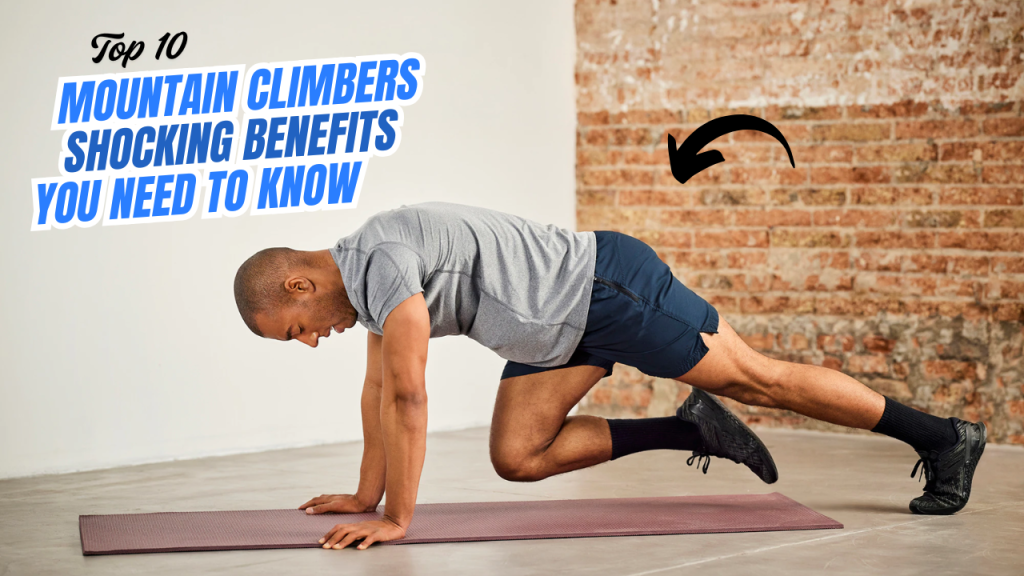“One move, infinite results.”
That’s how fitness pros often describe mountain climbers. But are you really unlocking all the benefits this humble floor exercise offers?
You may think of it as just another warm-up or core blaster, but here’s the shocker: mountain climbers are a full-body power move disguised as a simple cardio drill. Whether you’re aiming for fat loss, lean muscle, improved posture, or explosive athletic performance—this underrated exercise checks all the boxes.
Still, skipping them? You’re about to change your mind.

1. Burns Calories Faster Than Running

Shocking but true—mountain climbers can torch more calories per minute than jogging on a treadmill. Due to its high-intensity, compound nature, it revs up your heart rate rapidly and engages multiple large muscle groups at once.
Did You Know? A 155-pound person can burn around 10–11 calories per minute doing mountain climbers—almost equal to jump rope or high-knee sprints.
Why it matters:
- Boosts overall calorie deficit
- Efficient for HIIT and quick home workouts
- Great for busy people needing fast results
2. Full-Body Muscle Activation

Mountain climbers aren’t just a core exercise—they’re a total-body challenge. Your shoulders stabilize, arms support, core controls movement, glutes engage, and legs drive the motion.
Benefit highlights:
- Builds lean muscle tone
- Increases muscular endurance
- Enhances coordination and neuromuscular control
Fitness Myth Busted:
“Mountain climbers only work your abs.” Nope—this move activates nearly every major muscle group in the body.
3. Explosive Core Strength (Beyond Abs)
Yes, you’ll feel the burn in your abs—but the core includes more than just the six-pack. Mountain climbers engage the deep stabilizers, including the transverse abdominis, obliques, and lower back muscles.
Why it’s unique:
- Improves spinal stability
- Supports better posture
- Enhances balance and body control
4. Improves Cardiovascular Health

Done in sets or intervals, mountain climbers mimic sprinting but with less joint impact. Your heart pumps harder, lungs expand, and blood flow increases—strengthening your cardiovascular system.
Especially helpful for:
- People avoiding high-impact workouts
- Home exercisers without cardio machines
- Anyone seeking heart-healthy routines
5. Accelerates Fat Loss

Because of the combo of cardio + strength, mountain climbers create the afterburn effect (EPOC), which means you keep burning fat even after you stop.
Fat-Burning Tip (No Gimmicks):
Use mountain climbers in HIIT circuits or supersets for maximum fat-shredding impact.
6. Enhances Agility and Coordination
Mountain climbers improve foot speed, reaction time, and movement accuracy. Think of them as a conditioning drill for your nervous system.
How this helps:
- Boosts athletic performance
- Makes everyday movements sharper
- Prepares you for quick direction changes (important in sports)
Fact: Many professional athletes use mountain climbers to train quick feet and spatial awareness.
7. Builds Mental Grit

Let’s be real: mountain climbers are tough. But that’s the point.
They teach you to push through fatigue, build mental endurance, and stay laser-focused under pressure.
The psychology behind it:
- Boosts confidence in your body’s resilience
- Strengthens discipline and workout consistency
- Trains the mind for real-life challenges
8. Improves Mobility and Flexibility
With every rep, you stretch your hip flexors, hamstrings, and calves, while also stabilizing your spine and shoulders.
Functional benefits:
- Reduces tightness from sitting all day
- Improves joint range of motion
- Enhances movement flow and fluidity
Common Misconception: “You need yoga to become flexible.”
Not always. Dynamic movements like mountain climbers can improve flexibility when done regularly.
9. Requires No Equipment (Yet Delivers Gym-Level Results)
This bodyweight move is free, portable, and adaptable—ideal for:
- Travel workouts
- Small-space training
- Zero-equipment routines
And with variations like cross-body, slow-motion, or sliders, you can adjust the intensity without needing machines.
Quick Tip: Add mountain climbers to your morning routine—you’ll feel instantly energized and alert.
10. Elevates Athletic Performance
The mix of speed, control, power, and endurance mirrors the demands of sports—especially for athletes needing core power and fast directional change.
Sports it benefits:
- Football, basketball, soccer (footwork + stamina)
- Tennis (core rotation + agility)
- Martial arts (explosiveness + focus)
Did You Know? Combat athletes use mountain climbers to mimic explosive bursts in real fights.
Final Thoughts: You’re Probably Underestimating Mountain Climbers
They may look simple. But mountain climbers are a powerhouse move that combines cardio, strength, coordination, and mental toughness—in just seconds. If you’re not already incorporating them into your routine, you’re missing out on one of fitness’s most versatile, fat-burning, performance-boosting weapons.
So next time you hit the floor—don’t rush through your climbers. Embrace them. Master them. And watch how your body transforms.
Frequently Asked Questions (FAQs)
How many mountain climbers should I do per day?
It depends on your fitness level and goals. Beginners can start with 3 sets of 20–30 seconds each, while advanced users may do 4–5 sets of 60 seconds or incorporate them into HIIT workouts.
Are mountain climbers good for weight loss?
Yes, mountain climbers are excellent for weight loss. They burn calories quickly, elevate your heart rate, and activate multiple muscle groups—making them a top choice for fat-burning routines.
Do mountain climbers help tone your stomach?
Absolutely. Mountain climbers target your core muscles, especially the rectus abdominis, obliques, and transverse abdominis, helping to tone and strengthen your midsection over time.
Can beginners do mountain climbers safely?
Yes, but beginners should focus on slow, controlled movement to build form before increasing speed. Modifying by elevating your hands on a bench can also reduce pressure on the wrists and lower back.
Do mountain climbers build muscle or just burn fat?
They do both. While primarily a cardiovascular exercise, mountain climbers also engage and strengthen muscles in the core, shoulders, arms, glutes, and legs—especially when done regularly.
How long should I do mountain climbers to see results?
With consistent practice (3–4 times per week), you may start noticing improvements in core strength, endurance, and fat loss in as little as 2–3 weeks—especially when paired with a balanced diet and workout plan.
Are mountain climbers better than crunches?
Mountain climbers offer more overall benefits than crunches. While crunches isolate the abs, mountain climbers work the full core, burn more calories, and provide cardio conditioning.
Can I do mountain climbers every day?
Yes, if done in moderation. You can include them daily in short bursts as part of warm-ups or quick cardio, but intense, long sessions should be alternated with rest or other exercises to prevent overuse.
Do mountain climbers hurt the knees or wrists?
When done with proper form, mountain climbers are safe. However, those with existing joint issues should modify the move, reduce intensity, or consult a fitness expert or physical therapist before starting.





